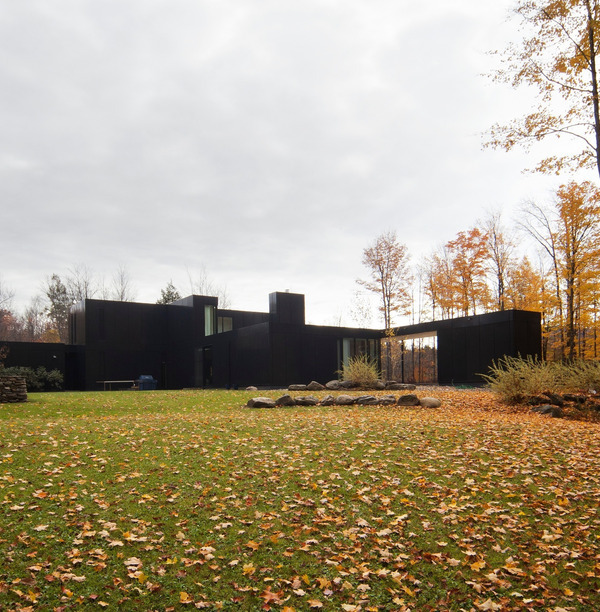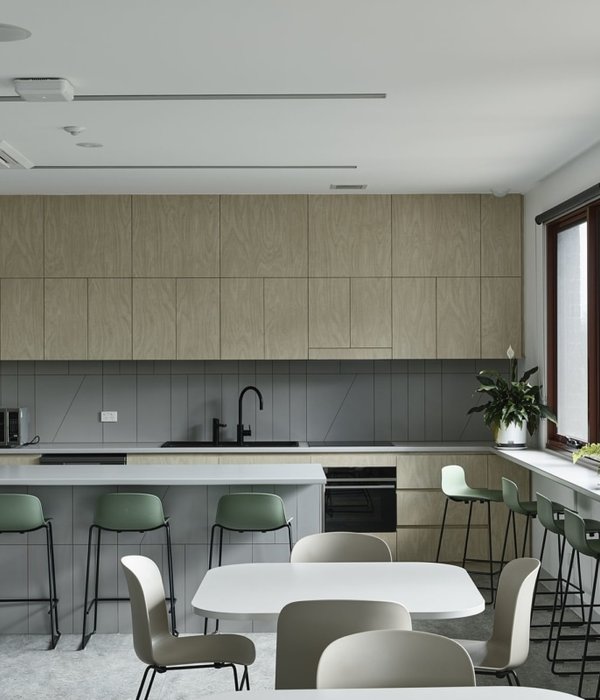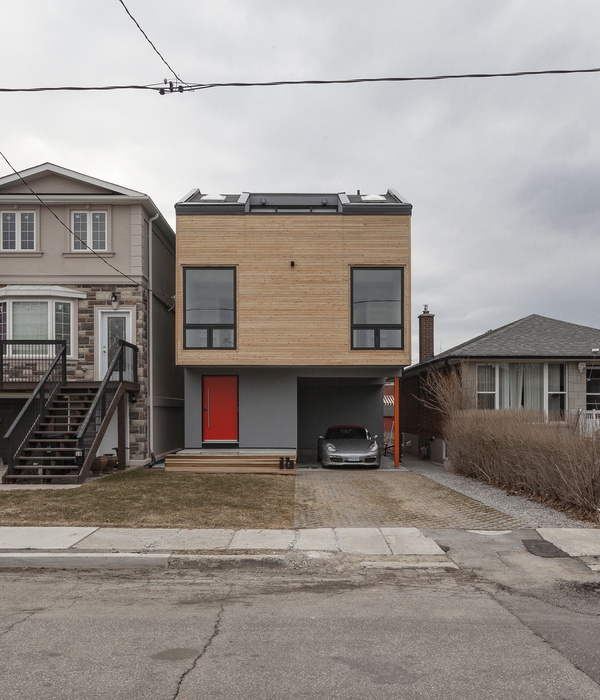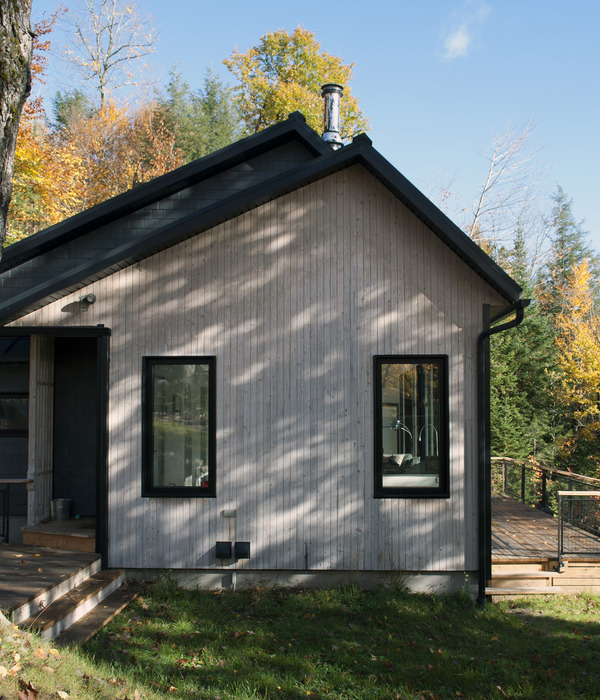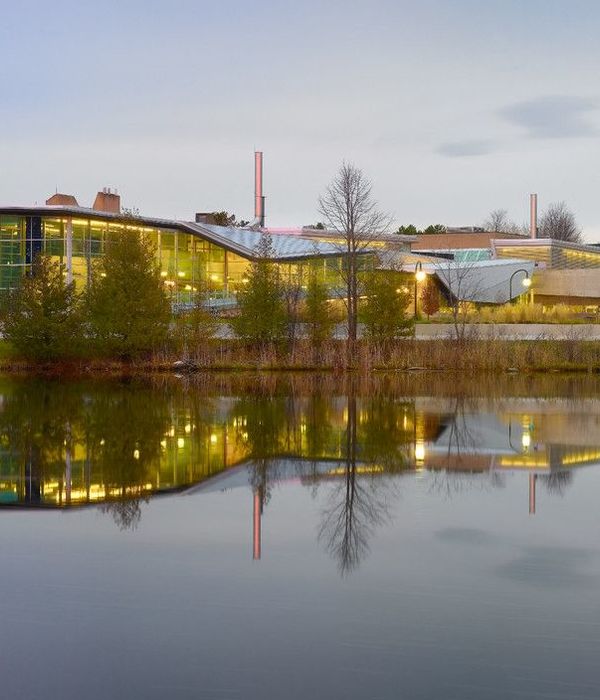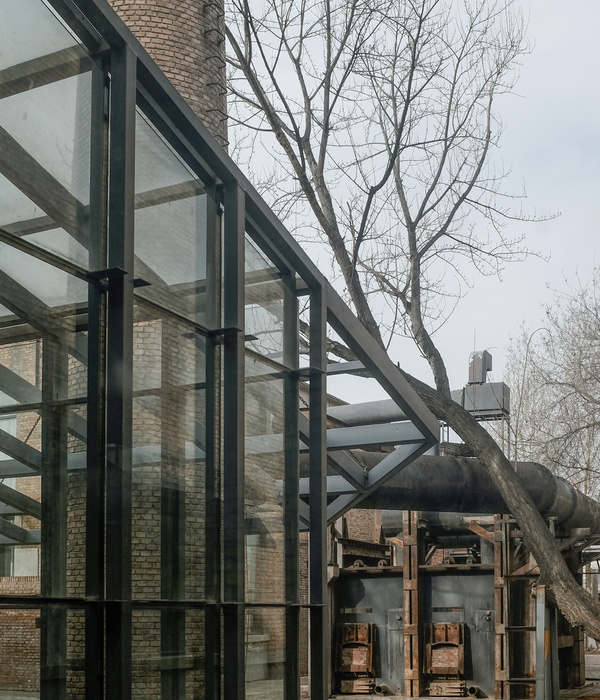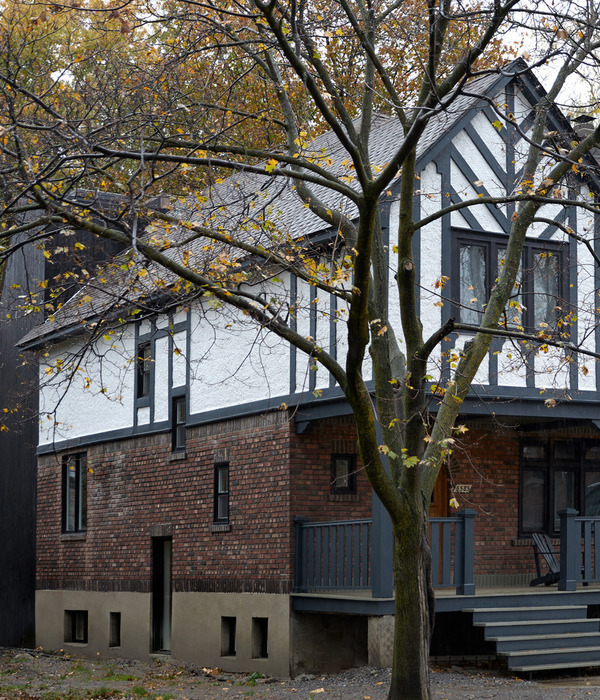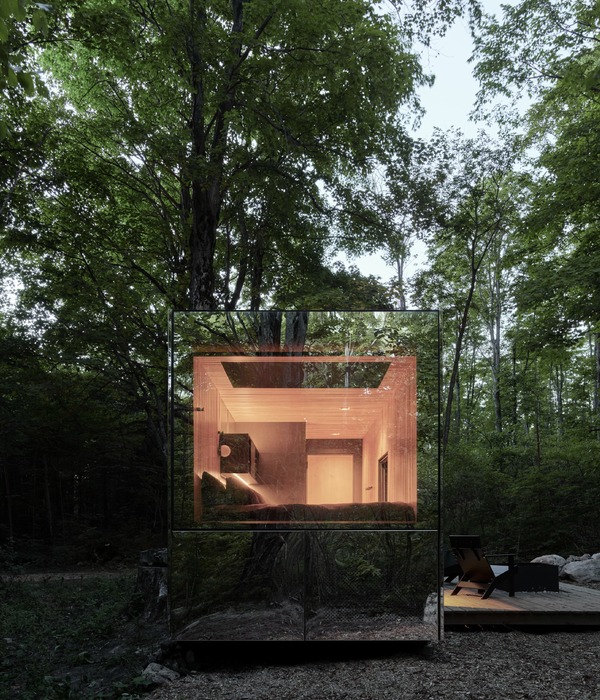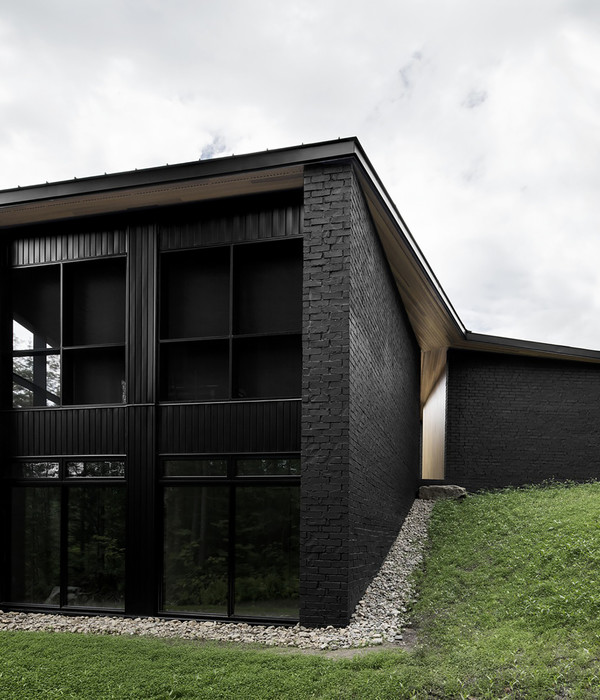项目位于巴塞罗那Fabra&Coats旧工业园区,建筑的前身是一座老旧的纺织工厂仓库,项目内容包括将这个19到20世纪建造的纺织厂综合体改造成社会性公寓以及COLLA CASTELLERA JOVE全新总部,并将其纳入“BCN创意工厂”计划中。该项目将为圣安德鲁地区(Sant Andreu)带来超过28000平方米的全新生活服务设施,第一次工业改造阶段将创造46套住宅单元,其中包括41套青年公寓以及5套纺织业相关的艺术家临时住宅,每套住宅均含有两间卧室。
▼项目概览,overall of the project © Jordi Surroca + Gael del Río / Roldán + Berengué arqts.
The transformation project of the warehouse building of the old industrial complex of Fabra & Coats in Barcelona is included in the process of reconversion of this textile complex of the XIX and XX centuries to incorporate it to the “BCN creation factories” network. The project will bring to the Sant Andreu district more than 28,000 m2 of facilities and, as a first time in an industrial heritage transformation, social housing is included. The project includes 46 housing units of two bedrooms: 41 units for young people and 5 units as a temporal residence for artists in relation with the complex.
▼项目外观,appearance © Jordi Surroca + Gael del Río / Roldán + Berengué arqts.
项目旨在保留原有的建筑元素,在创造新功能的同时,重新利用原有的空间、材料,以及历史品质,使改造后的建筑更加高效,同时凸显出原建筑的价值。
The intervention in the building activates all the elements of the original building creating the new program, and reuses its physical, spatial and historical qualities to make the new construction more efficient and to reinforce the character of the original building.
▼改造过程&轴测分析图,diagram & axonometric drawing © Roldán + Berengué
原建筑长100米,建筑的长度即为决定空间尺度的首要元素。设计师在建筑的中心设置了一个室内广场,从这里开始,走廊与楼梯等公共空间成对角线趋势分层上升,由底层延伸至顶层天花板,这种设置,不管从空间的角度还是从视觉的角度,都将室内空间连通了起来。
The original building is 100m long, where the first decision was to bring the value of its maximum dimension, which is the length. We access through the center creating an interior square where the promenade of the interior stairs begins in diagonal double ascending. The original building is communicated physically and visually from the ground level until the roof structure.
▼建筑的中心的室内广场,interior square in the the center of the building © Jordi Surroca + Gael del Río / Roldán + Berengué arqts.
▼走廊与楼梯等公共空间成对角线趋势分层上升, the promenade of the interior stairs begins in diagonal double ascending © Jordi Surroca + Gael del Río / Roldán + Berengué arqts.
▼一侧的楼梯与公共平台,stairs and common terrace on the one side © Jordi Surroca + Gael del Río / Roldán + Berengué arqts.
▼由公共平台看中央庭院,viewing the central courtyard from the public terrace © Jordi Surroca + Gael del Río / Roldán + Berengué arqts.
▼公共平台,public terrace © Jordi Surroca + Gael del Río / Roldán + Berengué arqts.
改造后的建筑内饰十分纯粹,如原有的工业建筑一样,仅由几种材料组合而成。木材以各种形式出现在室内空间中,如实木,纤维板,胶合板等。各种材料仿佛织物一般交合在一起。在“缝合”与“不缝合”之间,产生出一种组合与解构主义之美,亦可组合亦可拆解,所有过程都是可逆的。设计师重新利用了原建筑内部的两个楼层结构,并在其中插入了两个新的住宅楼层,原楼层负载能力可达1100公斤/平方米,因此并没有经过任何加固处理。
The new construction is by assemblage, it is a dry construction with just few materials, as in the original industrial building. Wood is used in all its forms: solid, agglomerated, cross laminated… Materials are joined as if it was a textile. To sew and un-sew, the new construction by its character and assemblage, can be assembled and disassembled, so it is “reversible”. Structural reuse of the two inner floors of the building, using them without any reinforcement (load capacity of 1,100kg/m2) to support on both floors the two new levels of housing.
▼木材以各种形式出现在室内空间中,wood is used in all its forms © Jordi Surroca + Gael del Río / Roldán + Berengué arqts.
▼走廊,corridor © Jordi Surroca + Gael del Río / Roldán + Berengué arqts.
建筑的立面以及屋顶作为住宅单元主要的保温隔热元素,均采用了木质立面进行改造。住宅单元的木制立面与原建筑的砖砌墙体隔开了一部分距离,实现了有效的保温与隔热效果。这种设置使空气可以在缝隙空间中流通,形成自然通风为室内降温,因此在一年内的大部分时间中,住宅单元内都不需要开空调。
Façade and roof of the building as a thermic buffer for the housing units. The new housing units are placed separated from the façade and the original roof of the building, with a new wooden façade. The in-between space is created to circulate the air; therefore, the housing units do not require the air conditioning the most part of the year.
▼木制立面与原建筑的砖砌墙体隔开了一部分距离,new wooden façade separated from the façade and the original roof of the building © Jordi Surroca + Gael del Río / Roldán + Berengué arqts.
项目内的另一处改造建筑,在100米长的集合住宅的一端,项目的前身是原纺织厂仓库于1950年扩建的部分,曾作为Colla Castellera Jove“叠人塔”协会在巴塞罗那的总部使用。室内空间的改造遵循了两个原则:1. 保证建筑室内外的连续性,即将室内空间向综合体的公共广场开放,在这里, 队员们可以进行户外培训。2. 保证内部空间之间的视觉交互,即利用缝隙空间以及透明的金属外立面,使室内的“叠人塔”活动清晰地展现在人们眼前。
One side of the building, the result of an extension on 1950, has been destined for the headquarters of the “Colla Castellera Jove” in Barcelona. The adjacent building, 100 m long, has been transformed into a complex of 46 social housing units. The new building is organized following two principles: Interior-exterior continuity: 1. the interior spaces get open to the public square of the complex, where outdoor training can be done. 2. Visual interaction between the interior spaces: gaps and transparent metal enclosures allow us to follow the activities of the human towers from anywhere in the building.
▼Colla Castellera Jove 新总部概览,overall of the Colla Castellera Jove new headquarter © Jordi Surroca + Gael del Río / Roldán + Berengué arqts.
主要的活动空间长宽高分别为10米,是依据对“叠人塔”的分析而定制的。“叠人塔”是一种高难度的西班牙体操形式,队员由下到上组成金字塔,在理想状态下,下方队员仅承受压力。“叠人塔”组成后,上方队员会进行其他体操活动展示,需要较大的空间,因此整个改造空间以留白为主。通常来讲,叠起来的“人塔”层数越多,底层队员的负载越大,最终呈现出“叠人塔”(castle)的形式。为了防止由于运动产生的震荡或因超重造成的“人塔”倒塌,底层“塔基”需由三组队员组成,塔基三层从下往上分别叫做:Pinya,folre,manilles。
To configure the main space, the training room for human towers (10x10x10 m), is based on the analysis of human towers: pyramidal structures that work, ideally, with pure compression. Due to their operation, they fill the space, creating an empty space around them. The more load a floor has, the more section it has, and the drop of loads is displayed in the shape of the castle. To prevent buckling due to movements or collapse due to excess weight, the obstacles are placed: “pinya, folre, manilles”.
▼”叠人塔”与项目整体轴测分析图,the “human tower” and axonometric diagram of the whole project © Roldán + Berengué
改造后的新建筑结构采用了与“叠人塔”相同的构成逻辑,支撑结构宛如贝壳一般,在内部留出了大量的留白空间。顶层的楼板采用了三维桁架结构,由楼板、桁架和屋顶组成,并由周围墙壁支撑。墙壁为支撑结构提供了压力,将楼板牢牢地锁住,以巧妙而隐蔽的方式创造出开敞的大空间。
The new structure is conceived in a complementary way to a human tower: it works like a shell, creating an empty space inside. The upper floor under roof is a three-dimensional suspended structure that does not make its operation evident. It is formed by the slabs, the trusses and the roof, and is supported by the perimeter walls, which work at flexo-compression locked by the slabs.
▼支撑结构宛如贝壳一样,在内部留出了大量的留白空间,it works like a shell, creating an empty space inside © Jordi Surroca + Gael del Río / Roldán + Berengué arqts.
组合的建造方式为项目赋予了极大的灵活性与可逆性,此外,如同其相邻的集合住宅一样,Colla Castellera Jove总部活动空间也采用了与原建筑相同的材料,包括金属,木材,以及砖石。建筑师将原建筑的外立面作为改造后建筑的保温层。45厘米厚的砖墙与屋顶瓷制瓦片起到了良好的保温隔热效果。与集合住宅相同,上层房间的立面与原立面分离,形成通风的缝隙空间,使房间在一年内的大部分时间里保持凉爽。
The new construction is by “assembly”. It is a dry and reversible construction made, as in the adjacent building of houses with a limited number of materials: steel, wood and brick, all of them already existing in the original building. The existing building acts as a thermal buffer for the building. The 45 cm brick wall and the ceramic tile roof of the original building provide with its thermal insulation mass and the façade of the upper room is separated from the original façade, creating an intermediate space through which the air circulates with the aim of that the room should not be heated for most of the year.
▼采用了与原建筑相同的材料,包括金属,木材,以及砖石,steel, wood and brick, all of them already existing in the original building © Jordi Surroca + Gael del Río / Roldán + Berengué arqts.
本项目实现了工业遗产与社会住宅以及文化综合体的完美结合与转化。在青年人与艺术家入住后,将为项目内的公共空间注入更多的社会性联系与活力。这些公共空间则会成为临时性的艺术品展览场地,共享工作空间以及交流空间,建筑中心的室内公共广场将成为建筑与圣安德鲁地区的汇合点。
Action: Industrial heritage + social housing + cultural complex. The housing units will be occupied by young people and artists of the complex, who will make the most of the social common space. This space will combine temporary art interventions, with spaces for working and exchanging ideas, acting this way the building as a point of union between the district of San Andreu and the interior square of Can Fabra.
▼项目的新旧对比与融合,the contrast and fusion of old and new © Jordi Surroca + Gael del Río / Roldán + Berengué arqts.
▼夜景,night view © Jordi Surroca + Gael del Río / Roldán + Berengué arqts.
▼手工模型,model © Roldán + Berengué
▼总平面图,master plan © Roldán + Berengué
▼项目图纸,project drawings © Roldán + Berengué
PROMOTER: Institut Municipal de l’Habitatge i Rehabilitació, Barcelona City Council
ARCHITECTS: José Miguel Roldán i Mercè Berengué, Roldán + Berengué, arqts. ARCHITECTS COLLABORATORS, R + B arqts.: Vicenç Sanz, Zana Bosnic, David Espuña, Miquel Canyellas STRUCTURE: Jordi Bernuz (Bernuz-Fernández arquitectes) INSTALATIONS: Josep Dalmau (CABA) DIRECTION OF EXECUTION: Salvador Arisa, Joan Just CONSTRUCTION COMPANY: Sacyr PHOTOGRAPHER: Jordi Surroca + Gael del Río / Roldán + Berengué arqts.
SITUATION: c/ Parellada 9 08030 Barcelona QUALIFICATION: HD/p – (7), Social housing for young people TOTAL BUILT AREA: 5.391,95 m2 COLLA CASTELLERA BUILDING AREA: 1.113,22 m2 NUMBER OF DWELLINGS: 46 dwellings: 44 of 2 bedrooms i 2 of 1 bedroom BUILT AREA OF ONE DWELLING: 59,1 m2 USEFUL AREA OF ONE DWELLING: 53,26 m2 ENERGY RATING: A
{{item.text_origin}}

